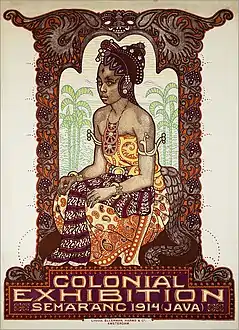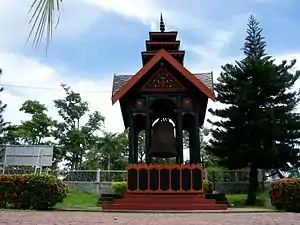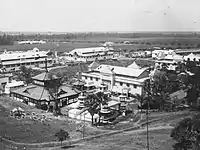| 1914 Semarang | |
|---|---|
 Exhibition poster | |
| Overview | |
| BIE-class | Unrecognized exposition |
| Name | Colonial Exhibition |
| Area | 26 ha |
| Visitors | 677,266 |
| Participant(s) | |
| Countries | 20 |
| Location | |
| Country | Dutch East Indies (now Indonesia) |
| City | Semarang |
| Coordinates | 6°59′S 110°25′E / 6.983°S 110.417°E |
| Timeline | |
| Opening | 20 August 1914 |
| Closure | 22 November 1914 |
The Colonial Exhibition, Dutch: Koloniale Tentoonstelling, took place in Semarang, Dutch East Indies (now Indonesia) in from 20 August through 22 November 1914.[1]: cover Colonial exhibitions were trade expositions. It was designed to "give a comprehensive picture of the Dutch Indies in their present prosperous condition."[2] It was the first large scale exposition in the Dutch East Indies,[1]: 2 and financed by the participating corporations with a subsidy from the Dutch East Indies government.[1]: 6–7
The architect was Maclaine Pont.[1]: 22
Exhibits
There were displays including companies, foreign states and areas within the Dutch East Indies. One area of the grounds had pavilions dedicated to cocoa, coffee, kapok, and tea.[3]
Dutch East Indies
There was a Balinese, an Aceh pavilion central Java, and Semerang pavilions.
 Central Java diorama
Central Java diorama
Foreign states
There were pavilions from Australia, China, Formosa (Taiwan) and Japan.
 Chinese Pavilion
Chinese Pavilion
 Japanese Pavilion
Japanese Pavilion
Companies
There were pavilions from several companies including German hardware manufacturing business Carl Schlieper, the Netherland Indies Gas Company (NIGM), Nestlé, and the Dutch shipping company Koninklijke Paketvaart-Maatschappij (KPM).
 Carl Schlieper pavilion
Carl Schlieper pavilion Trocadero pavilion (left), NIGM pavilion (center) and the Nestlé pavilion (right)
Trocadero pavilion (left), NIGM pavilion (center) and the Nestlé pavilion (right)_op_de_Koloniale_Tentoonstelling_in_Semarang_TMnr_60039523.jpg.webp) NIGM pavilion
NIGM pavilion_op_de_Koloniale_Tentoonstelling_in_Semarang_TMnr_60039521.jpg.webp) Koninklijke Paketvaart Maatschappij (KPM) pavilion
Koninklijke Paketvaart Maatschappij (KPM) pavilion
Legacy
The Aceh state pavilion was built in Acehnese style, without nails.[4]
After the exposition, it was dismounted and re-erected as the Aceh Museum, where it and the Cakra Donya Bell also displayed remain.
 Aceh pavilion with Cakra bell during the exposition
Aceh pavilion with Cakra bell during the exposition Cakra Donya bell in 2005
Cakra Donya bell in 2005 Pavilion building at the Aceh museum in 2005
Pavilion building at the Aceh museum in 2005
Gallery
 Aerial view of the colonial exhibition of Semarang
Aerial view of the colonial exhibition of Semarang Main Entrance
Main Entrance Umbrella manufacturing
Umbrella manufacturing Rail transport demonstration from Krupp
Rail transport demonstration from Krupp Stage
Stage Visit of Governor General A.W.F. Idenburg to the exhibition
Visit of Governor General A.W.F. Idenburg to the exhibition Trade pavilion
Trade pavilion Bandstand Traffic Pavilion and the pavilion of F.J. Fuchs (a carriage supply and automobile distributor)
Bandstand Traffic Pavilion and the pavilion of F.J. Fuchs (a carriage supply and automobile distributor) Fountain
Fountain Party room and terrace
Party room and terrace
References
- 1 2 3 4 M.G. van Heel (2016). Gedenkboek van de Koloniale Tentoonstelling Semarang. Mercurius.
- ↑ "Calendar". The Independent. 13 Jul 1914. Retrieved 5 August 2012.
- ↑ KOLONIAL-TENTOONSTELLING SEMARANG 1914 Plattegrond (Map) (in Dutch).
- ↑ "Rumah Aceh | Banda Aceh, Indonesia Attractions - Lonely Planet". Retrieved 12 May 2020.
External links
- Colonial Exhibition of Semarang catalog University of Leiden Library
- Colonial Exhibition in Semarang 1914 Video including several contemporaneous photographs.